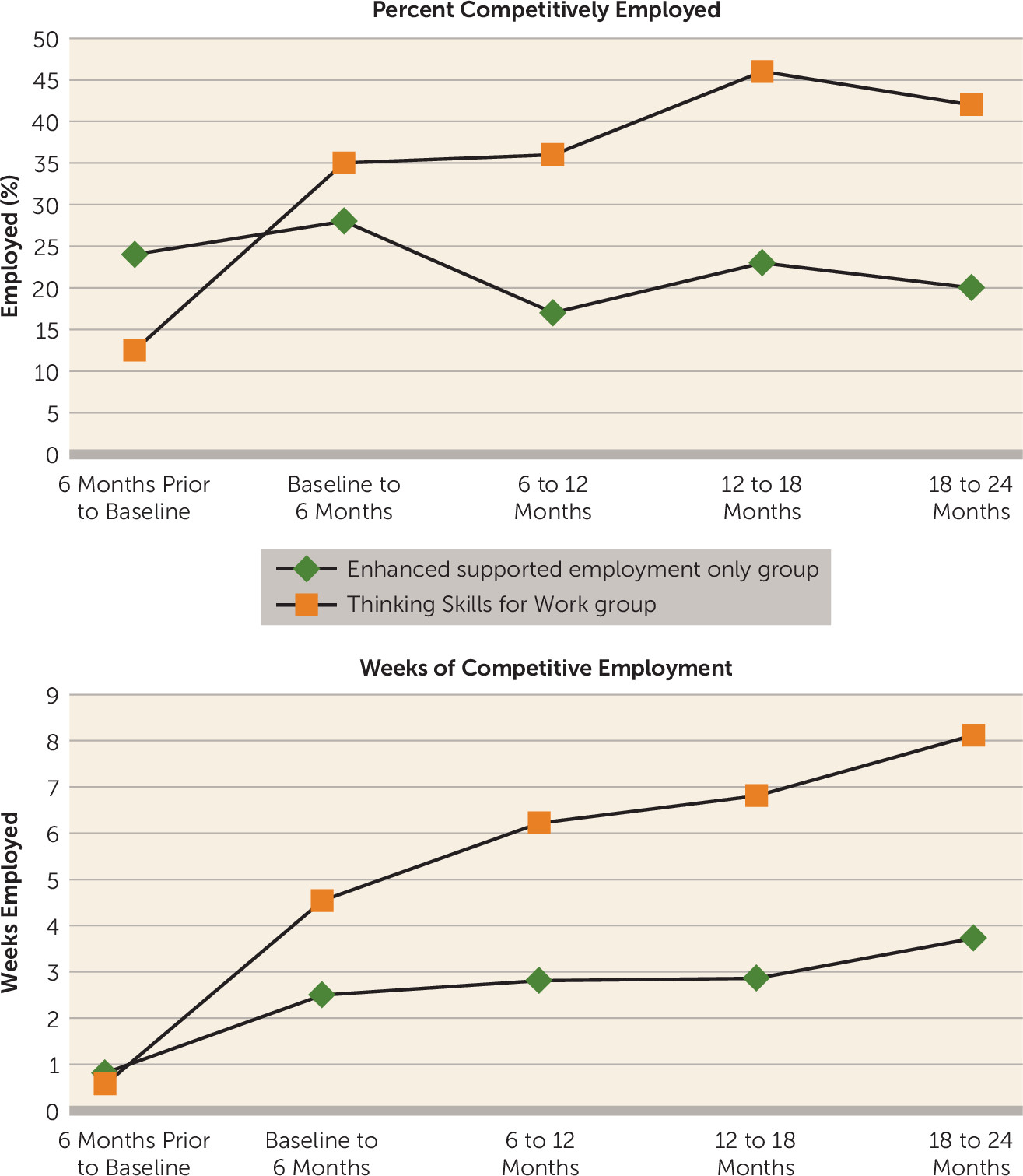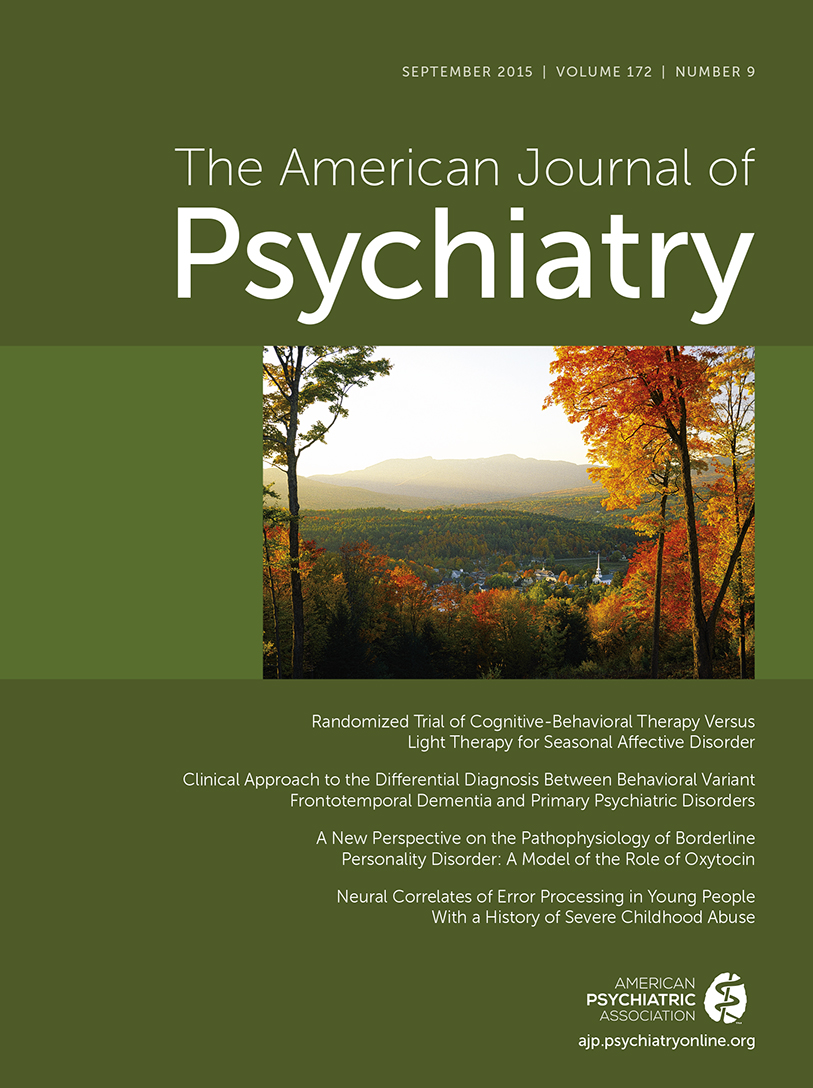Cognitive Enhancement Treatment for People With Mental Illness Who Do Not Respond to Supported Employment: A Randomized Controlled Trial
Abstract
Objective:
Method:
Results:
Conclusions:
Method
Sites
Participants
| Variable | Thinking Skills for Work (N=57) | Enhanced Supported Employment Only (N=50) | Total | |||
|---|---|---|---|---|---|---|
| Mean | SD | Mean | SD | Mean | SD | |
| Age (years) | 45.12 | 11.33 | 42.94 | 10.71 | 44.07 | 11.04 |
| N | % | N | % | N | % | |
| Site | ||||||
| Manchester, N.H. | 38 | 66.7 | 37 | 74.0 | 75 | 70.0 |
| Chicago | 19 | 33.3 | 13 | 26.0 | 32 | 30.0 |
| Male | 34 | 59.6 | 36 | 72.0 | 70 | 65.4 |
| Hispanic | 5 | 8.8 | 7 | 14.0 | 12 | 11.2 |
| Race | ||||||
| White | 49 | 86.0 | 43 | 86.0 | 92 | 86.0 |
| Black or African American | 6 | 10.5 | 5 | 10.0 | 11 | 10.3 |
| Asian | 1 | 1.8 | 1 | 2.0 | 2 | 1.9 |
| More than one race | 1 | 1.8 | 1 | 2.0 | 2 | 1.9 |
| Marital status | ||||||
| Never married | 35 | 61.4 | 34 | 68.0 | 69 | 64.5 |
| Married | 5 | 8.8 | 5 | 10.0 | 10 | 9.3 |
| Separated | 1 | 1.8 | 3 | 6.0 | 4 | 3.7 |
| Divorced | 14 | 24.6 | 7 | 14.0 | 21 | 19.6 |
| Widowed | 2 | 3.5 | 1 | 2.0 | 3 | 2.8 |
| Education | ||||||
| Less than high school | 16 | 28.1 | 15 | 30.0 | 31 | 29.0 |
| High school, GED, or more | 41 | 71.9 | 35 | 70.0 | 76 | 71.0 |
| Diagnosis | ||||||
| Schizophrenia | 14 | 24.6 | 11 | 22.0 | 25 | 23.4 |
| Schizoaffective disorder | 11 | 19.3 | 13 | 26.0 | 24 | 22.4 |
| Bipolar disorder | 12 | 21.1 | 13 | 26.0 | 25 | 23.4 |
| Major depression | 12 | 21.1 | 6 | 12.0 | 18 | 16.8 |
| Other | 8 | 14.0 | 7 | 14.0 | 15 | 14.0 |
| Current substance use disorder | ||||||
| None | 43 | 75.4 | 32 | 65.3 | 75 | 70.8 |
| Alcohol use disorder | 3 | 5.3 | 2 | 4.1 | 5 | 4.7 |
| Drug use disorder | 3 | 5.3 | 10 | 20.4 | 13 | 12.3 |
| Alcohol and drug use disorder | 8 | 14.0 | 5 | 10.2 | 13 | 12.3 |
| Lifetime substance use disorder | ||||||
| None | 24 | 42.1 | 17 | 34.7 | 41 | 38.7 |
| Alcohol use disorder | 11 | 19.3 | 6 | 12.2 | 17 | 16.0 |
| Drug use disorder | 7 | 12.3 | 8 | 16.3 | 15 | 14.2 |
| Alcohol and drug use disorder | 15 | 26.3 | 18 | 36.7 | 33 | 31.1 |
| Competitive work history (12 months or more) | 10 | 17.5 | 9 | 18.0 | 19 | 17.8 |
| Competitive work in past 5 years | 33 | 61.1 | 35 | 72.9 | 68 | 66.7 |
| Competitive work in past 6 months | 7 | 12.5 | 12 | 24.0 | 19 | 17.9 |
| Did not work in supported employment in past 3 months | 47 | 82.5 | 41 | 82.0 | 88 | 82.2 |
| Job loss in supported employment in past 3 months | 10 | 17.5 | 9 | 18.0 | 19 | 17.8 |
| Mean | SD | Mean | SD | Mean | SD | |
| Months of supported employment before baseline | 26.11 | 32.05 | 18.10 | 20.93 | 22.36 | 26.85 |
| Weeks of competitive work 6 months before baseline | 0.57 | 2.03 | 0.81 | 2.16 | 0.68 | 2.09 |
Assessment
Measures
Interventions
Enhanced supported employment.
Thinking Skills for Work program.
Fidelity
Screening, Recruitment, and Randomization
Statistical Analysis
Patient Perspectives
Results
Cognitive Outcomes
| Treatment Group Effect | Group-by-Diagnosis Interaction | ||||||
|---|---|---|---|---|---|---|---|
| Measure | df | F | p | Effect Size | df | F | p |
| Composite cognitive score | 1, 98 | 8.31 | 0.005 | 0.50 | 1, 98 | 3.59 | 0.06 |
| Trail Making Test, part A | 1, 96 | 2.23 | 0.13 | –0.14 | 1, 96 | 0.26 | 0.60 |
| Trail Making Test, part B | 1, 95 | 10.93 | 0.001 | –0.48 | 1, 95 | 2.59 | 0.11 |
| Symbol coding (Brief Assessment of Cognition in Schizophrenia) | 1, 107 | 1.41 | 0.23 | 0.14 | 1, 106 | 0.42 | 0.51 |
| Hopkins Verbal Learning Test–Revised, delayed | 1, 92 | 2.30 | 0.13 | 0.24 | 1, 91 | 0.83 | 0.70 |
| Hopkins Verbal Learning Test–Revised, sum 1–3 | 1, 113 | 0.39 | 0.53 | 0.04 | 1, 112 | 0.84 | 0.36 |
| Spatial span | 1, 95 | 0.02 | 0.87 | 0.07 | 1, 94 | 1.57 | 0.21 |
| Letter-number span | 1, 94 | 0.16 | 0.68 | 0.02 | 1, 93 | 3.17 | 0.07 |
| Mazes test (Neuropsychological Assessment Battery) | 1, 91 | 0.15 | 0.69 | 0.08 | 1, 91 | 1.24 | 0.26 |
| Brief Visuospatial Memory Test–Revised, delayed recall | 1, 94 | 1.76 | 0.18 | 0.40 | 1, 94 | 0.00 | 0.94 |
| Brief Visuospatial Memory Test–Revised, total trials 1–3 | 1, 97 | 4.69 | 0.03 | 0.50 | 1, 97 | 2.03 | 0.15 |
| Category fluency | 1, 88 | 1.42 | 0.23 | 0.17 | 1, 87 | 5.13 | 0.02 |
| Mayer-Salovey-Caruso Emotional Intelligence Test | 1, 92 | 0.51 | 0.47 | 0.07 | 1, 91 | 2.41 | 0.12 |
| Continuous Performance Test, Identical Pairs version | 1, 94 | 2.94 | 0.08 | 0.24 | 1, 94 | 3.87 | 0.05 |
Work Outcomes
| Time Effect | Treatment Group Effect | ||||||
|---|---|---|---|---|---|---|---|
| Work Variable | F | df | p | F | df | p | Effect Size |
| Any competitive work | 1.61 | 3, 235 | 0.18 | 8.97 | 1, 95 | 0.003 | 0.49 |
| Weeks of competitive work | 2.42 | 3, 235 | 0.06 | 6.24 | 1, 95 | 0.01 | 0.41 |
| Wages from competitive work (log) | 1.50 | 3, 237 | 0.21 | 7.15 | 1, 97 | 0.008 | 0.47 |
| Any paid work | 0.96 | 3, 235 | 0.41 | 6.20 | 1, 95 | 0.01 | 0.40 |
| Weeks of paid work | 3.32 | 3, 235 | 0.02 | 4.63 | 1, 95 | 0.03 | 0.41 |
| Wages from paid work (log) | 2.72 | 3, 237 | 0.21 | 4.84 | 1, 97 | 0.03 | 0.37 |

| Measure | Thinking Skills for Work (N=57) | Enhanced Supported Employment Only (N=50) | Analysis | |||
|---|---|---|---|---|---|---|
| Competitive employment | ||||||
| Mean | SD | Mean | SD | Mann-Whitney (Z) | p | |
| Number of jobs | 0.98 | 1.09 | 0.76 | 1.34 | 1.90 | 0.05 |
| Weeks worked | 23.9 | 31.4 | 9.2 | 19.6 | 2.58 | 0.01 |
| Wages earned ($) | 3,421 | 5,719 | 1,728 | 4,531 | 2.27 | 0.02 |
| Hours worked | 397 | 671 | 185 | 453 | 2.25 | 0.02 |
| Duration of first job (weeks) | 29.8 | 31.1 | 15.4 | 21.4 | 1.20 | 0.22 |
| N | % | N | % | χ2 | p | |
| Any competitive work | 34 | 60 | 18 | 36 | 5.96 | 0.02 |
| All paid employment | ||||||
| Mean | SD | Mean | SD | Mann-Whitney (Z) | p | |
| Number of jobs | 1.16 | 1.14 | 0.96 | 1.48 | 1.68 | 0.09 |
| Weeks worked | 26.7 | 32.6 | 13.1 | 25.2 | 2.27 | 0.02 |
| Wages earned ($) | 3,512 | 5,713 | 2,171 | 4,900 | 2.00 | 0.04 |
| Hours worked | 420 | 671 | 231 | 495 | 2.03 | 0.04 |
| Duration of first job (weeks) | 29.9 | 31.1 | 13.1 | 20.0 | 1.93 | 0.05 |
| N | % | N | % | χ2 | p | |
| Any paid work | 37 | 65 | 22 | 44 | 4.70 | 0.03 |
Symptoms and Quality of Life
Discussion
Acknowledgments
Footnote
Supplementary Material
- View/Download
- 485.17 KB
- Download
- 6.38 MB
References
Information & Authors
Information
Published In
History
Authors
Competing Interests
Funding Information
Metrics & Citations
Metrics
Citations
Export Citations
If you have the appropriate software installed, you can download article citation data to the citation manager of your choice. Simply select your manager software from the list below and click Download.
For more information or tips please see 'Downloading to a citation manager' in the Help menu.
View Options
View options
PDF/EPUB
View PDF/EPUBLogin options
Already a subscriber? Access your subscription through your login credentials or your institution for full access to this article.
Personal login Institutional Login Open Athens loginNot a subscriber?
PsychiatryOnline subscription options offer access to the DSM-5-TR® library, books, journals, CME, and patient resources. This all-in-one virtual library provides psychiatrists and mental health professionals with key resources for diagnosis, treatment, research, and professional development.
Need more help? PsychiatryOnline Customer Service may be reached by emailing [email protected] or by calling 800-368-5777 (in the U.S.) or 703-907-7322 (outside the U.S.).

